The big news stories in 1989 were, as usual, disasters and
world turmoil: an earthquake in the San Francisco Bay area killed 67 people;
the Exxon Valdez ran aground in Alaska’s Prince William Sound, spilling 11
million gallons of oil; and Chinese students rallying for democracy in
Tiananmen Square resulted in hundreds of deaths as the government cracked down.
Twenty-five years ago also was a time of great hope in the
future: after 28 years, the Berlin Wall was dismantled and democratic reforms
were sweeping eastern Europe; the new prime minister in South Africa, F.W. De
Klerk, began the process of removing apartheid; and the World Wide Web was
created.
Amidst all this, Findlay College, which had been founded in
1882, became The University of Findlay.
 Like the world scene, Findlay College was facing external challenges.
The number of graduating high school seniors was predicted to steadily decline
over the next decade, greatly impacting recruitment of traditional students;
international students preferred to enroll in American “universities” because
in other countries “college” meant high school; and the national movement of
technical schools becoming state community colleges threatened enrollment of
students in traditional liberal arts colleges.
Like the world scene, Findlay College was facing external challenges.
The number of graduating high school seniors was predicted to steadily decline
over the next decade, greatly impacting recruitment of traditional students;
international students preferred to enroll in American “universities” because
in other countries “college” meant high school; and the national movement of
technical schools becoming state community colleges threatened enrollment of
students in traditional liberal arts colleges.
There also was much cause for optimism. Responding to a
downturn in enrollment in the mid-1970s, Findlay College had been pushing the
boundaries of a liberal arts education with successful, innovative programs.
Findlay established an Intensive English Language Institute for international
students; implemented the western equestrian studies and pre-veterinary
medicine programs; acquired the Nuclear Medicine Institute; received several
million dollars in federal aid to support bilingual, multicultural education
programs; and launched the nation’s first bachelor’s degree in hazardous waste
studies (which is now environment, health, safety, and sustainability).
As a result of these bold moves and others, Findlay College
was doing well in the mid-1980s in recruiting traditional age students, as well
as adults who participated in the Weekend College and evening division
programs. Findlay even was sending professors to Lima, Ohio, to teach in
growing prisoner education programs at Lima and Allen County Correctional
Institutions. In fact, enrollment had risen to a historic high of 2,075
students in fall 1988, increasing from 1,408 in 1983.
Addressing how Findlay could become an even stronger
institution and thrive in the future, despite the looming challenges, then-President
Kenneth E. Zirkle, Ed.D., formed a strategic planning committee and named
faculty member N. Susan Bakaitis, Ph.D., as chair. The initial proposal for
changing the name from Findlay College to The University of Findlay was made as
a part of the strategic planning process. The committee reflected a cross
section of the school and administration, and supported the idea.
Members of the committee, who researched other institutions
that had moved from college to university status, reported increased pride by
alumni, students, faculty and friends; an improved marketing position in
recruiting students, both domestic and international; greater student
retention; and greater success in obtaining outside funding, as a result.
Following the board of trustees meeting on Oct. 28, 1988,
Findlay released an announcement by Jack Harrington, chairman of the board,
that the decision had been made for Findlay College to change its name to The
University of Findlay, effective July 1, 1989. The change reflected Findlay’s
growth in enrollment and increase in academic programming, including the
addition of its first modern graduate degree.
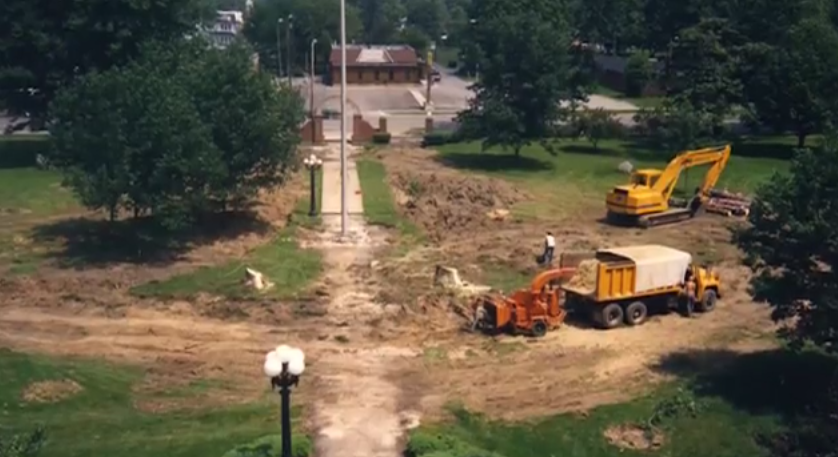 Honoring its history of being jointly founded by the
Churches of God, General Conference, and the citizens of Findlay, a formal
dedication of The University of Findlay was held on Aug. 8, 1989. The August
date was selected so members of the Churches of God, who were attending its
annual national Summer Seminar on campus, could participate, as well as
representatives and citizens of the city.
Honoring its history of being jointly founded by the
Churches of God, General Conference, and the citizens of Findlay, a formal
dedication of The University of Findlay was held on Aug. 8, 1989. The August
date was selected so members of the Churches of God, who were attending its
annual national Summer Seminar on campus, could participate, as well as
representatives and citizens of the city.
The front lawn of Old Main was renovated and the Arch was moved
back away from Main Street when Findlay College
became The University of Findlay.
By changing its name and strategically setting a path for
growth, Findlay altered its identity and its future. In 2014, The University of
Findlay is celebrating 25 years of growth and achievements.
Academic Programs
The administration, faculty and staff worked diligently to
implement other components of the strategic plan. Graduate degrees were created
in quick succession: Master of Arts in Teaching English to Speakers of Other
Languages (TESOL) and Bilingual Education - 1989; Master of Arts in Education –
1992; Master of Business Administration – 1993; and Master of Science in
Environmental, Safety and Health Management – 1994.
By 2000, business and environmental degree completion and
graduate programs were offered online. In 2001, the MBA program was named one
of 39 “Best of the Online Grad Programs” by U.S. World & News Report, and UF was named one of “America’s
Most Wired Colleges” by Yahoo! Internet Life and Peterson’s.
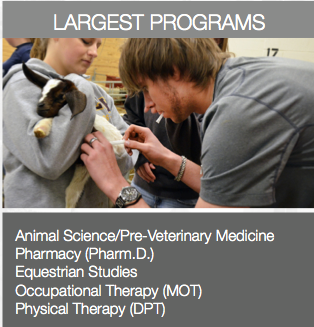
Specialized programs were developed routinely over the past
25 years. Hospitality management, Japanese (language), forensic science,
operations and logistics, law and the liberal arts, children’s book
illustration, sport and event management, positron emission
tomography/computerized tomography technology (PET/CT), equestrian studies –
English riding, and animal science were among the new undergraduate offerings.
Seven more master’s degrees were added between 2000 and
2013. In 2006, a Doctor of Pharmacy (Pharm.D.) degree began, with the first
doctoral students graduating in 2010. The physical therapy program transitioned
to a doctoral program in 2008, and an online Doctor of Education (Ed.D.) was
added in 2013.
The pace of advancement has never slackened. The University
of Findlay now offers 53 undergraduate majors, nine master’s degrees and three
doctoral programs, which are organized into six colleges: Business; Education; Health Professions; Arts, Humanities, and Social Sciences; Pharmacy; and Sciences.
Graduate Programs
Added Since 1989
1989 – Master of Arts in Teaching English to Speakers of
Other Languages (TESOL) and Bilingual Education
1992 – Master of Education
1993 – Master of Business Administration
1994 – Master of Science in Environmental, Safety and Health
Management
2000 – Master of Occupational Therapy
2000 – Master of Physical Therapy
2001 – Master of Arts in Liberal Studies (Discontinued in
2010)
2003 – Master of Athletic Training
2006 – Doctor of Pharmacy
2008 – Doctor Physical Therapy
2010 – Master of Physician Assistant
2011 – Master of Science in Health Informatics
2013 – Master of Arts in Rhetoric and Writing
2013 – Doctor of Education
(Ed.D.)
Expanding Enrollment
The composition of the student body has changed dramatically
in 25 years. In 1989, 440 new, full-time traditional students enrolled in the
fall, compared to 750 new, incoming students in the fall of 2013 (most recent
year available). Twenty-five years ago, 146 international students were on
campus. In fall 2013, 336 international students were enrolled in
undergraduate, graduate and the Intensive English Language programs. Total
enrollment was 2,215 in fall 1989, compared with 3,668 in fall 2013.
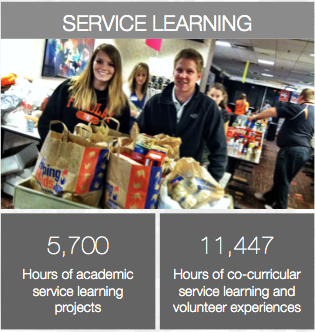
Today, there are more than 2,600 undergraduate students,
with 1,200 students living in campus housing, ranging from residence halls to
townhouses, cottages, apartments and special interest houses.
More than 1,000 students in graduate programs make up 28
percent of the student body, with many of them taking classes online. In
addition, more than 1,200 high school students are enrolled in UF’s
post-secondary options program.
Changes in the institution also are illustrated by the
graduating classes. Using the commencement programs from 1989 and 2014 as a
reference: a total of 278 degrees were awarded in 1989, compared to 924 in 2014.
| Bachelor of Arts |
187 |
67% |
112 |
12% |
|---|
| Bachelor of Science |
9 |
3% |
439 |
47% |
|---|
| Associate of Arts |
82 |
30% |
34 |
3% |
|---|
| Graduate Degrees |
0 |
0% |
358 |
38% |
|---|
(Unofficial totals using commencement program tallies)
Enlarging the Campus
The physical campus needed to grow to accommodate the
expanding enrollment and the many programs requiring special facilities. After
nearly two decades of the campus remaining static, the construction of the Phil
Gardner Fitness Center in 1989 kicked off 25 years of expansion.
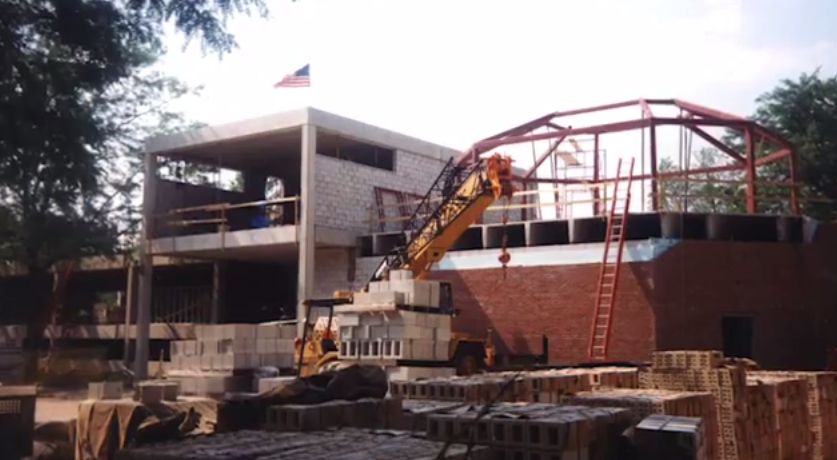
Construction on the Kenneth L. Frost Science Center
Between 1991 and 1999, the Kenneth L. Frost Science Center,
the Virginia B. Gardner Fine Arts Pavilion, the Edward and Joyce Brewer Center
for Health Sciences and the Ralph and Gladys Koehler Fitness and Recreation
Complex were constructed on campus, and the All Hazards Training Center and the
James L. Child Jr. Equestrian Complex (English riding and dressage) were
developed off site.
Construction on the Koehler Fitness and Recreation Complex
In 2001, the Dennis A. Zahler Townhouses provided the first
new option in student living. The land for the Russ & Peg Armstrong Sports
Complex on Blanchard Avenue was acquired in 2002, and opened with six
professional-grade tennis courts in 2005.
In 2003, Winebrenner Theological Seminary (WTS) moved to a
new building located at the corner of North Main and Frazer Streets, contiguous
to campus. Although separate entities, Winebrenner and The University of
Findlay share various academic and support services for greater efficiencies,
and the WTS building was a significant addition to Findlay’s campus.
The University acquired the Winebrenner Village care
facility in 2003, which became the UF Village. It was converted to residence
rooms, administrative offices and facilities for the hospitality management
major. The former Findlay campus of Owens Community College on Davis Street,
purchased in 2006, was renovated to provide the largest square footage of
instructional space since the construction of Old Main.
Existing buildings that received significant additions
included: the Alumni Memorial Union, Henderson Dining Hall, Egner Center for
the Performing Arts and the Virginia B. Gardner Fine Arts Pavilion addition in
2007 for the Mazza Museum. The Carrothers Home for the President was
extensively remodeled with additions in 1990 and 2010.
The classrooms and offices on the second and third floors of
Old Main received a makeover in 2012, along with the installation of air
conditioning for the first time in its history.
New facilities included the Dr. C. Richard Beckett Animal
Science Building in 2009 and the science addition to the Davis Street Building
in 2012, the first new green construction utilizing geothermal heating and
cooling and other energy-saving technologies.
In 1989, the main campus covered just 25 acres; in 2014, it
totals 88 acres. Total acreage in 1989 for the main campus, training center and
the western equestrian farm was 102 acres; today it is 394 acres for the main campus
and off-site properties, which include the Center for Animal Sciences (western
equestrian and pre-veterinary medicine programs), the James L. Child Jr.
Equestrian Complex (English equestrian programs), the All Hazards
Training Center, Reick Center for Habitat Studies, Olive Street Wilderness Area
and the Armstrong Sports Complex.
Athletics
Findlay has been engaged in competitive sports throughout
its history and has a loyal following of fans in the community, as well as
students and alumni. For a mid-size institution, Findlay has an outstanding
record. More than 600 students participate on athletic teams, which is nearly a
quarter of the undergraduate student body.
During the past 25 years, The University of Findlay has
transitioned from National Association of Intercollegiate Athletics (NAIA) to National
Collegiate Athletic Association (NCAA) competition, and from Division III to
Division II, enabling UF to offer athletic scholarships.
Findlay has earned a number national championship crowns. In
addition to the team championships, many Findlay athletes have earned national
championship titles. Currently, Findlay fields 22 NCAA teams and five equestrian
teams, which compete in the Intercollegiate Horse Show Association (IHSA), United States Eventing Association (USEA), and Intercollegiate Dressage Association (IDA). Competing
regionally in the Great Lakes Intercollegiate Athletic Conference, UF has
proved to be a formidable opponent, garnering numerous titles and accolades in
regional play, as well.
Athletics: from NAIA to NCAA
Number of Sports Teams
1989 – 18 (NAIA - 10 men’s and 8 women’s)
2014 – 22 (NCAA - 12 men’s and 10 women’s; IHSA - 2
Equestrian)
National Championships
NAIA Football National Championships – 1992, 1995, 1997
NAIA Wrestling National Championship – 1995
NCAA Men’s Basketball National Championship – 2009
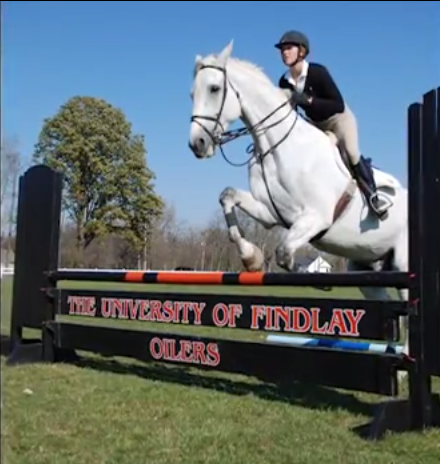
Equestrian National Championships
Western Equestrian – 2001, 2005, 2007, 2009, 2010, 2018, 2019
English Equestrian – 2001
For Findlay, becoming a university has been a winning move.
As an institution, it has thrived with the introduction of new programs, an
increase in students and the expansion of campus and facilities.
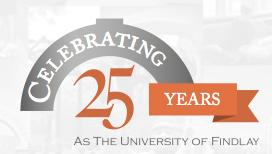 The leadership of three presidents – Dr. Kenneth E. Zirkle,
Dr. DeBow Freed and Dr. Katherine Fell, combined with the efforts of the
members of the Board of Trustees, administrators, faculty, staff, alumni,
donors, and support from the founding denomination and community members, has
created a university that has become one of the largest private educational
institutions in northwest Ohio.
The leadership of three presidents – Dr. Kenneth E. Zirkle,
Dr. DeBow Freed and Dr. Katherine Fell, combined with the efforts of the
members of the Board of Trustees, administrators, faculty, staff, alumni,
donors, and support from the founding denomination and community members, has
created a university that has become one of the largest private educational
institutions in northwest Ohio.